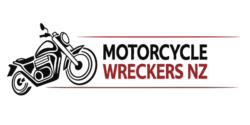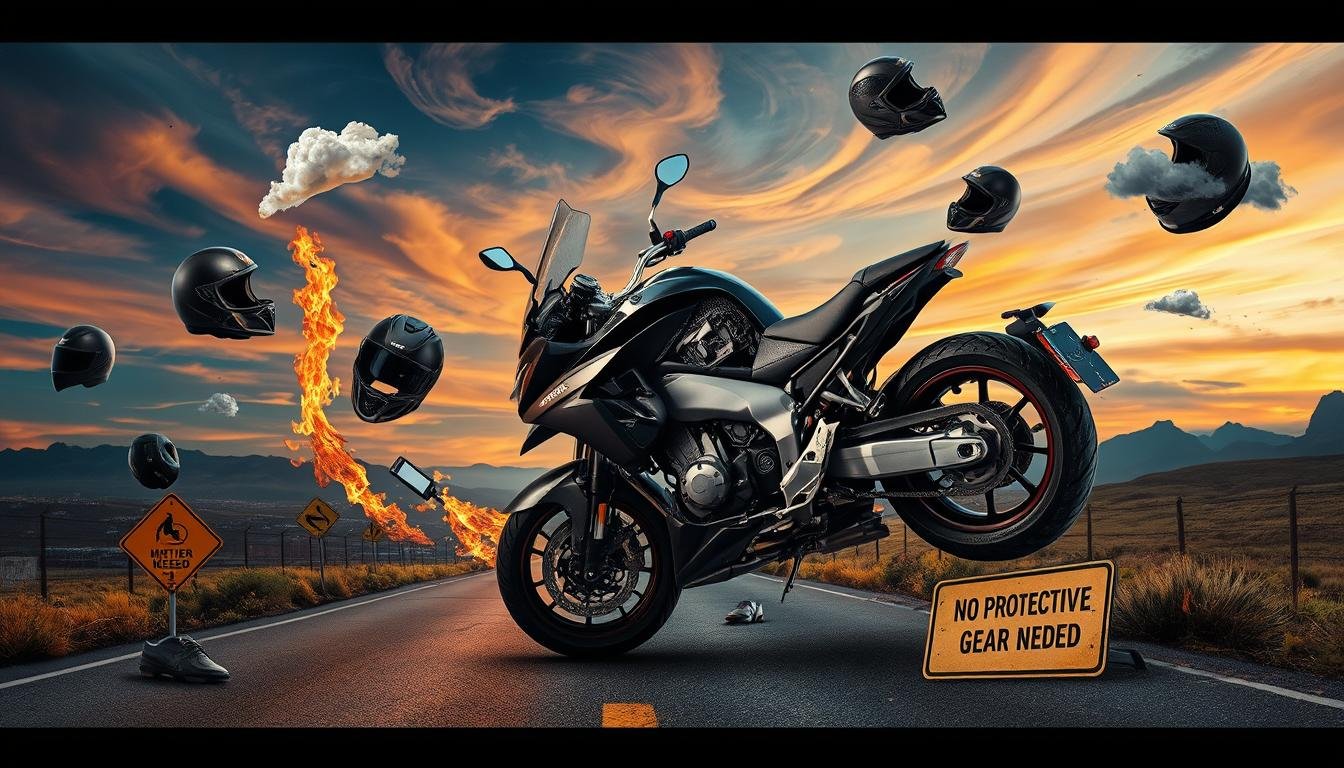In 2022, motorcycle riders were 28 times more likely to die in a crash than car occupants in Australia. This shocking fact from the Bureau of Infrastructure and Transport Research Economics shows why we need to know the truth about motorcycle wrecking. Let’s explore the world of motorcycle wreckers and salvage yards to clear up myths from facts.
Riding a motorbike is exciting, but it’s also risky. Many riders believe false things about motorcycle accidents, repairs, and safety. These myths can cause bad choices and risky situations on the road. It’s time to correct these common beliefs.
In this article, we’ll look at 10 myths about motorcycle wrecking that are common in Australia. Knowing the truth about these myths will help you make smarter choices about your riding, safety gear, and what to do in a motorcycle wreck.
Key Takeaways
- Motorcycle riders face higher risks than car occupants in Australia
- Common myths about motorcycle wrecking can lead to unsafe practices
- Understanding the realities of accidents and repairs is crucial for riders
- Motorcycle wreckers and salvage yards play a significant role in the industry
- Debunking these myths can help improve rider safety and decision-making
Myth 1: Motorcycle Wrecks Are Rare in Australia
Many Aussies think motorcycle accidents are rare. But the truth is different. This myth makes riders less careful and hurts road safety efforts. Let’s look at the facts and figures to see how often bike wrecks happen in Australia.
Statistical Insights on Motorcycle Accidents
Recent data shows a worrying trend in motorcycle accidents across the country. In 2022, motorcyclists made up 18% of all road fatalities. Yet, they only make up 4% of registered vehicles. This shows riders face a higher risk on Australian roads.
| Vehicle Type | Percentage of Registered Vehicles | Percentage of Road Fatalities |
|---|---|---|
| Motorcycles | 4% | 18% |
| Cars | 75% | 45% |
| Other Vehicles | 21% | 37% |
The Reality of Accident Frequency
Motorcycle wrecks are more common than you might think. Every year, thousands of riders get into accidents. These can range from minor spills to severe crashes.
These incidents affect riders and create a need for bike dismantlers and parts recycling. The environmental impact is also big, as damaged bikes often need special disposal.
Knowing how often motorcycle accidents happen is key to safer riding. By understanding the risks, riders can take steps to protect themselves and others on the road.
Myth 2: Only Inexperienced Riders Wreck Motorcycles
Riding experience is key to safety, but it’s not the only thing. We’ll look at how experience and safety are linked. We’ll also examine cases where even experienced riders crash.
The Role of Experience in Riding Safety
More experience means safer riding. Seasoned riders control their bikes better and spot dangers sooner. Yet, experience doesn’t make riders completely safe. Even the most skilled can face surprises that lead to accidents.
Famous Incidents Involving Experienced Riders
Many famous riders have had serious crashes. In 2017, MotoGP star Nicky Hayden sadly died in a cycling accident. Former World Superbike champion Troy Bayliss had a bad crash in 2007, needing major repairs and new parts.
“No matter how experienced you are, always ride within your limits and stay alert to your surroundings.”
These stories show accidents can happen to anyone, no matter their skill. Road conditions, other drivers, and brief distractions can cause wrecks. It’s important for all riders to focus on safety and keep improving their skills.
Myth 3: Wrecked Motorcycles Are Always Total Losses
Many riders think a wrecked motorcycle is always junk. This myth can lead to quick decisions about a bike’s future. But, the decision to repair or scrap is not always easy.
Understanding Repair vs. Total Loss
After a crash, a motorcycle’s future depends on many things. Insurance and mechanics check the damage to decide if it can be fixed. Sometimes, bikes that seem beyond repair can be fixed with the right parts and skills.
Motorcycle wreckers are key in this process. They look at the damage and repair costs against the bike’s value. Often, what seems like a total loss can be fixed for less, giving the bike a new life.
Factors Influencing Repair Decisions
Several things decide if a wrecked motorcycle can be fixed:
- How much damage there is
- If parts can be found
- If fixing it is cheaper than buying a new one
- The bike’s age and rarity
Salvage yards are full of used motorcycle parts. These parts can make a big difference. Skilled mechanics can often fix wrecked bikes, proving not every crash means the end.
Myth 4: Wearing Gear Is Just a Suggestion
Many riders think protective gear is optional. But this belief is dangerous. Wearing the right clothes is key to staying safe on the road.
The Importance of Protective Gear
Wearing the right gear can save your life in a crash. Good helmets, jackets, gloves, and boots protect you from serious injuries. Even in small crashes, the right gear can prevent injuries.
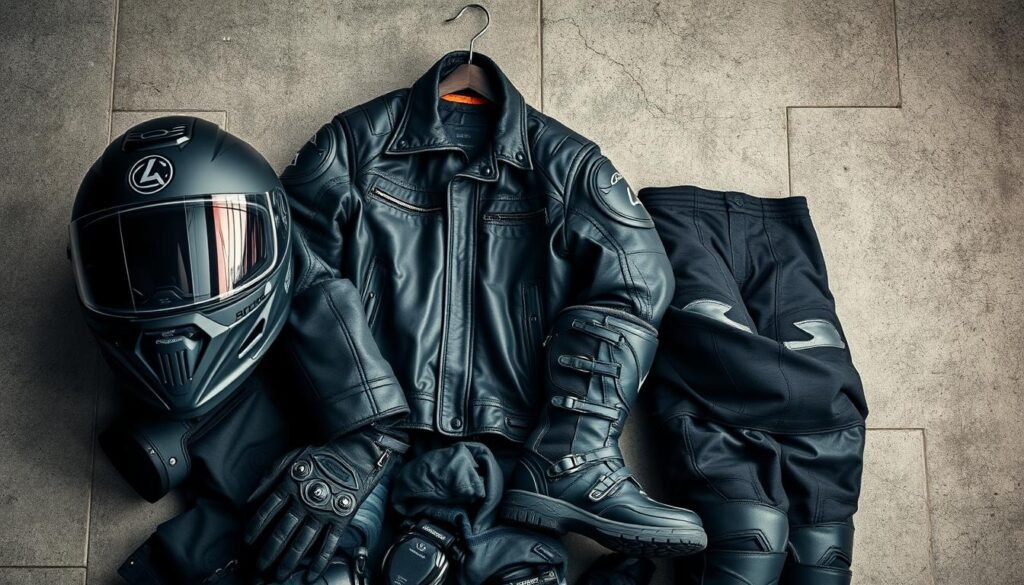
Bike dismantlers often see the damage from accidents where riders weren’t wearing gear. The damage to bodies without protection is much worse than to bikes. This shows how important safety gear is.
Common Misconceptions About Riding Attire
Some riders think regular clothes are enough. But they’re not. Motorcycle gear is made to handle impacts and abrasions that regular clothes can’t.
- Myth: Jeans provide adequate protection
- Fact: Motorcycle-specific pants with armour are much safer
- Myth: Any helmet will do
- Fact: Only DOT-approved helmets offer proper protection
Buying quality gear not only makes you safer but also helps the environment. Many protective items are made to be recycled, reducing waste.
| Gear Type | Protection Level | Environmental Impact |
|---|---|---|
| Full-face Helmet | High | Low (recyclable shell) |
| Leather Jacket | Medium | Medium (durable, long-lasting) |
| Armoured Pants | High | Low (removable armour for recycling) |
Remember, your gear is your last defence in a crash. Don’t risk your safety or the environment. It’s an investment in your life.
Myth 5: You Don’t Need a Licence for a Motorcycle
Riding a motorcycle in Australia needs a licence. This myth can cause legal and safety problems. We’ll look at the licensing rules and what happens if you ride without one.
Licensing Requirements in Australia
Every state in Australia has its own rules for motorcycle licences. The steps are:
- Getting a learner’s permit
- Doing a rider training course
- Passing a practical test
- Getting provisional licences
- Getting a full motorcycle licence
The licence system makes sure riders know how to ride safely. It’s important because riding can be risky. Also, if you crash, you need to know how to dispose of your vehicle properly.
Consequences of Riding Without a Licence
Riding without a licence can lead to big penalties:
| Consequence | Details |
|---|---|
| Fines | Up to $5,000 depending on the state |
| Demerit Points | 3-4 points on your driving record |
| Licence Suspension | Up to 3 months for first offence |
| Insurance Implications | Potential claim rejections, higher premiums |
Unlicensed riding can also mean your motorcycle might be written off after an accident. This could mean you lose your bike and finding parts becomes hard. Always make sure you have the right licence to stay safe and legal.
Myth 6: Motorcycles Are Less Safe Than Cars
Many think motorcycles are less safe than cars. This myth can lead to wrong ideas about bike safety. Let’s look at the truth and compare bike and car safety features.
Comparing Safety Features: Bikes vs. Cars
Cars may offer more protection, but bikes have their own safety pluses. Modern bikes have features like anti-lock braking and traction control. These can greatly lower accident risks, even on tough roads.
| Safety Feature | Motorcycles | Cars |
|---|---|---|
| Anti-lock Braking System | Available on many models | Standard on most models |
| Airbags | Limited availability | Standard on all models |
| Traction Control | Available on high-end models | Common on modern vehicles |
| Stability Control | Available on some models | Standard on most models |
The Role of Skill and Awareness in Safety
Rider skill and awareness are key to bike safety. Experienced riders who drive defensively can lower their accident risk. They stay alert to blind spots, predict other drivers, and keep a safe distance.
Motorcycle wreckers and salvage yards often see bikes from accidents. By looking at used parts, they share insights on bike design flaws. This helps makers improve safety and teaches riders about maintenance.
“Riding a motorcycle safely is not just about the bike’s features. It’s about the rider’s skills, awareness, and respect for the road.”
In summary, while bikes might not have all car safety features, they can be safe with the right riding. It’s all about rider education, skill, and using safety gear.
Myth 7: All Motorcycle Wrecks Are Caused by Riders
Many think motorcycle riders always cause accidents. This myth ignores the many factors that lead to wrecks. Let’s look at the truth and how external factors play a part in motorcycle accidents.
Exploring Factors Beyond Rider Control
Rider behaviour is important for safety, but it’s not everything. Other drivers, vehicle problems, and weather can also cause accidents. Bike dismantlers often see wrecks caused by things riders can’t control.
- Other drivers’ negligence or lack of awareness
- Mechanical failures
- Unexpected obstacles on the road
- Poor visibility due to weather conditions
The Impact of Road Conditions
Road conditions are key to motorcycle safety. Bad roads, sudden changes, and poor signs can cause accidents. We need better roads and upkeep.
| Road Condition | Potential Risk | Prevention Measure |
|---|---|---|
| Potholes | Loss of control | Regular road maintenance |
| Oil spills | Skidding | Quick clean-up protocols |
| Loose gravel | Reduced traction | Proper road construction techniques |
Knowing these factors helps make roads safer for everyone. It’s clear that preventing wrecks is a shared responsibility. By tackling these issues, we can make riding safer for all.
Myth 8: You Can’t Get Insurance on a Wrecked Bike
Many riders think insurance is hard to get for wrecked motorcycles. This myth leads to wrong ideas about getting rid of vehicles and insurance write-offs. Let’s find out the truth about insuring bikes that have been damaged before.
Types of Insurance Coverage Available
Insurance companies have many options for motorcycles, even those with damage before. These policies can help protect you and your bike, even after repairs from a wreck.
- Third-party property damage
- Comprehensive coverage
- Agreed value policies
- Laid-up insurance for non-operational bikes
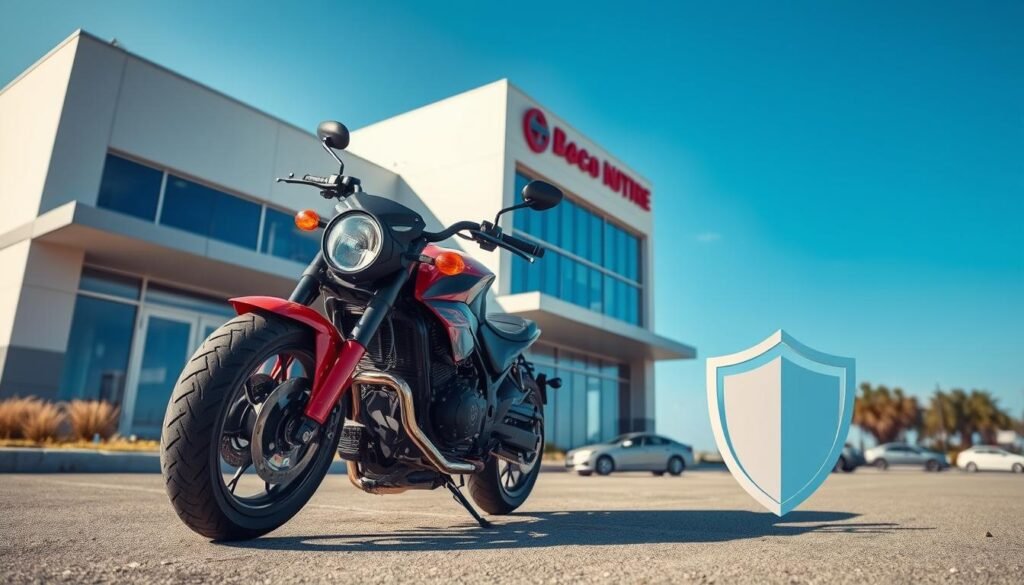
How to Insure a Previously Wrecked Motorcycle
Getting insurance for a repaired motorcycle needs honesty and the right documents. Here’s what you should know:
- Always tell your insurer about any damage before
- Show them repair receipts and inspection certificates
- Think about an agreed value policy for fair pay
- Be ready for possibly higher premiums
Remember, each case is looked at differently by insurers. A well-kept bike with good parts can still get insured, even after a wreck.
| Factor | Impact on Insurability |
|---|---|
| Extent of previous damage | Moderate to high |
| Quality of repairs | High |
| Current bike condition | Very high |
| Documentation of repairs | Critical |
By knowing your options and being honest with insurers, you can often get coverage for your wrecked motorcycle. This way, you can avoid getting rid of your bike and keep it on the road.
Myth 9: Maintaining a Wrecked Motorcycle Is Too Expensive
Many riders think fixing a wrecked bike will cost too much. This myth stops people from using salvage yards. Let’s look at the real costs and how smart maintenance can save you money.
Cost Breakdown of Repairing Wrecked Bikes
Fixing a wrecked motorcycle doesn’t have to be expensive. Smart riders use motorcycle wreckers and salvage yards for parts. These parts are often half the price of new ones and work just as well.
| Part | New Price | Used Price |
|---|---|---|
| Fairings | $800 | $300 |
| Forks | $600 | $250 |
| Engine | $2000 | $800 |
Long-Term Savings of Proper Maintenance
Regular upkeep stops small issues from becoming big problems. Changing oil, adjusting chains, and checking brakes can prevent costly breakdowns. By sourcing parts from reputable salvage yards, you keep your bike running smoothly without breaking the bank.
Remember, a well-maintained bike, even if once wrecked, can be as reliable as a new one. With smart choices and regular care, you can enjoy your ride without worrying about excessive costs.
Myth 10: Motorcycles Are Always Dangerous to Ride
Many think motorcycles are always dangerous. But this is not the whole story. Riding does come with risks, but you can take steps to lower them.
Balancing Risk with Reward in Motorcycling
Motorcycling brings its own set of thrills and benefits. It’s more fuel-efficient and better for the environment. To stay safe, get trained, stay alert, and wear the right gear. Bike dismantlers also help by recycling damaged parts safely.
Tips for Safe Riding Practices
Here are some tips to stay safe on the road:
- Wear full protective gear, including helmet, jacket, gloves, and boots
- Attend advanced riding courses to improve skills
- Maintain your motorcycle regularly
- Stay visible to other road users
- Ride within your limits and road conditions
By following these tips, you can enjoy motorcycling’s benefits while keeping risks low. Remember, recycling parts and disposing of them responsibly helps both rider safety and the environment.
| Safety Measure | Risk Reduction |
|---|---|
| Wearing a helmet | 37% reduction in fatal injuries |
| Protective clothing | 65% reduction in soft tissue injuries |
| Advanced rider training | 42% reduction in crash involvement |
The Legalities of Motorcycle Wrecking in Australia
Dealing with motorcycle wrecking in Australia can be complex. It’s important to know the laws about disposing of vehicles and insurance write-offs. This knowledge is vital for both riders and owners.
Understanding Australian Motorcycle Laws
Australian laws set rules for handling wrecked motorcycles. Each state has its own vehicle disposal rules. For example, in NSW, you must tell the Roads and Maritime Services within 14 days if your bike is written off. Not doing so can lead to big fines.
There are strict rules for salvaging motorcycle parts. You can’t just take parts without the right paperwork. This stops theft and keeps everyone safe.
Insurance Claims and Wrecked Vehicles
Handling insurance claims for wrecked motorcycles involves several steps:
- Report the accident to your insurer
- Get an assessment of the damage
- Determine if it’s a repairable or statutory write-off
- Process the claim and receive payment
Insurance write-offs are divided into two types: repairable and statutory. Repairable write-offs can be fixed and re-registered. Statutory write-offs can only be used for parts.
| Write-off Type | Can be Repaired? | Can be Re-registered? |
|---|---|---|
| Repairable | Yes | Yes, after inspection |
| Statutory | No | No |
If you’re buying a wrecked bike, check its history. A bike that’s been written off might have hidden problems. These could affect your safety on the road.
How to Spot Wrecked Motorcycles for Sale
When looking for a used motorcycle, it’s key to spot signs of wrecks. This helps you avoid expensive repairs and ensures a safe, reliable ride. Let’s look at how to spot wrecked bikes and what to ask sellers.
Signs of a Wrecked Motorcycle
Here are signs to look for when checking a used bike:
- Misaligned body panels or frame
- Inconsistent paint colour or texture
- Scratches or dents on engine casings
- Bent handlebars or footpegs
- Uneven tyre wear
These signs often mean the bike has been in an accident. Motorcycle wreckers and salvage yards often deal with such bikes. Knowing their practices can help.
Questions to Ask When Buying Second-Hand
When thinking about a used motorcycle, ask the seller:
- Has the bike been in any accidents?
- Are there any current mechanical issues?
- Can you provide service records?
- Where did you source replacement parts?
- Has the bike ever been written off?
These questions can give you important info about the bike’s history and condition. Good sellers often get parts from trusted salvage yards, ensuring quality.
“Always trust your instincts. If a deal seems too good to be true, it probably is.”
By being careful and asking the right questions, you can avoid buying a poorly fixed wreck. You can find a reliable used motorcycle that meets your needs.
The Environmental Impact of Motorcycle Wrecking
Motorcycle wrecking is key in reducing the environmental harm from old bikes. As we focus more on being green, the bike industry faces new hurdles and chances.
Recycling and Disposal of Wrecked Bikes
Bike dismantlers lead the way in safe disposal. They make sure wrecked bikes don’t pollute our soil and water.
- Metals like steel and aluminium are separated for recycling
- Plastic components are sorted for reprocessing
- Tyres are shredded and used in road construction
Eco-Friendly Practices in Wrecking
Recycling bike parts is a big part of being green. Many parts from old bikes can be fixed and sold again. This cuts down the need for new stuff, helping the planet.
| Component | Recycling Method | Environmental Benefit |
|---|---|---|
| Engine | Rebuilt or scrapped for metal | Reduces raw material extraction |
| Battery | Recycled for lead and plastic | Prevents toxic leakage |
| Oil | Refined and reused | Minimises water pollution |
The motorcycle wrecking world is working hard to lessen its harm on the environment. We can help by picking bike dismantlers who care about the planet.
Preparing for and Responding to Motorcycle Wrecks
Riding a motorcycle is exciting, but safety comes first. We’ll look at how to avoid wrecks and what to do if you’re in one.
Preventive Measures to Avoid Wrecks
To lower your accident risk, focus on these areas:
- Regular maintenance of your motorcycle parts
- Enhancing your riding skills through advanced courses
- Staying alert and aware of your surroundings
- Wearing proper safety gear at all times
What to Do Immediately After a Wreck
If you’re in a motorcycle wreck, follow these steps:
- Check for injuries and call emergency services if needed
- Move to a safe area if possible
- Document the scene with photos for insurance purposes
- Exchange information with other parties involved
- Contact your insurance company to report the incident
For severe damage, you might need to dispose of the vehicle or deal with insurance write-offs. Remember, even wrecked motorcycles have valuable parts.
| Item | Purpose |
|---|---|
| First-aid kit | Treat minor injuries |
| Emergency contact list | Quick access to important numbers |
| Basic tool kit | Minor repairs on the road |
| High-visibility vest | Increase visibility after a wreck |
Being prepared and knowing how to respond helps you handle motorcycle wrecks safely.
Understanding the Aftermath of Wrecks
Motorcycle wrecks can have a big impact, not just on the body. The emotional side is often overlooked but is key to healing. We’ll look at the psychological effects and where to find support after a crash.
The Emotional Impact of Motorcycle Wrecks
Being in a motorcycle wreck can stir up many feelings. Riders might feel anxious, depressed, or even guilty. These feelings can stick around long after the physical wounds heal.
It’s common for riders to find it hard to get back on their bikes or even drive. They might worry about riding again.
Visiting motorcycle wreckers or salvage yards can help. Seeing used parts can help riders process their feelings and face their fears about riding again.
Resources for Post-Accident Support
Recovery is not something you have to do alone. There are many resources to help riders get back on their feet:
- Counseling services specialising in trauma
- Rider support groups for shared experiences
- Rehabilitation programs focusing on both physical and mental recovery
Local motorcycle clubs also offer support. They can give advice on insurance claims and finding good motorcycle wreckers for repairs or parts.
| Support Type | Benefits |
|---|---|
| Professional Counseling | Tailored strategies for coping with trauma |
| Rider Support Groups | Shared experiences and peer support |
| Rehabilitation Programs | Comprehensive physical and mental recovery |
Remember, asking for help is a sign of strength. By tackling the emotional side of a wreck, you’re taking a big step towards feeling confident on the road again.
Myths About Motorcycle Safety Equipment
Motorcycle safety gear is key to protecting riders. But, many myths exist about its effectiveness. Let’s look at what safety gear really does and clear up common misconceptions.
What Safety Gear Really Protects You
Every rider needs quality safety gear. Helmets protect your head from impacts. Jackets and pants shield against road rash. Boots protect your ankles and feet, and gloves keep your hands safe during falls.
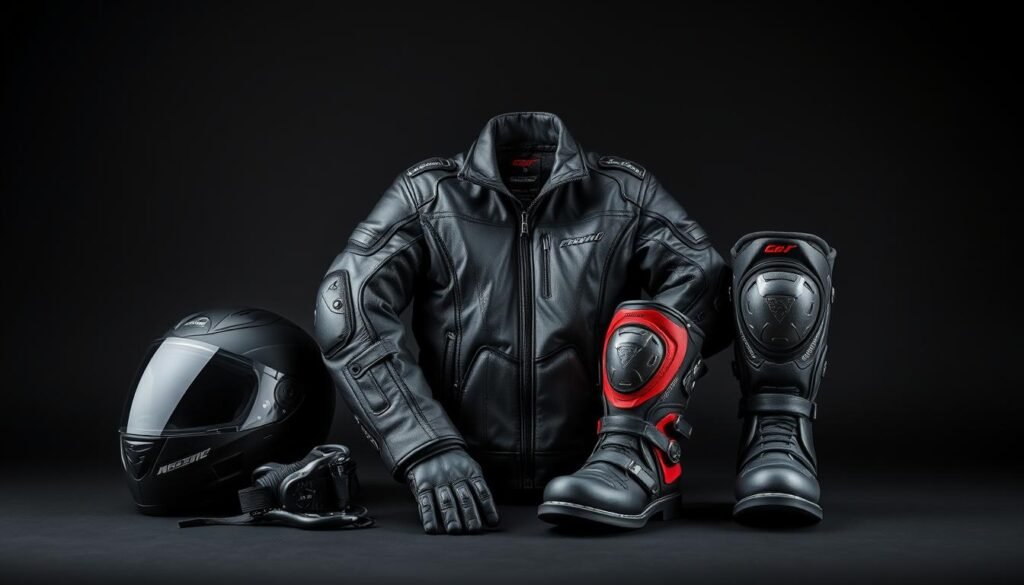
Bike dismantlers often salvage parts from wrecked bikes. This helps recycle parts, reducing the need for new ones and lessening environmental impact.
| Safety Gear | Protection Offered |
|---|---|
| Full-face Helmet | Head, face, chin protection |
| Leather Jacket | Abrasion resistance, impact protection |
| Riding Boots | Ankle support, foot protection |
| Gloves | Hand protection, improved grip |
Debunking Apparel Myths
Many think leather is the only good material for gear. But, modern synthetic fabrics are just as good. They’re lighter and more breathable. Full-face helmets aren’t just for racers; they’re the best choice for all riders.
It’s important to keep your gear in good shape. Regular checks ensure it works well. Just like how recycling parts helps keep motorcycles running longer.
Final Thoughts: Truths About Motorcycle Wrecking
In this article, we’ve looked at “10 Myths About Motorcycle Wrecking Debunked”. We found out that motorcycle wrecks aren’t as uncommon in Australia. Both new and experienced riders can have accidents. Not all wrecked bikes are total losses.
Reflecting on the Myths and Facts
Wearing the right gear can save lives, and having a licence is essential. Motorcycles can be as safe as cars if ridden well. Accidents aren’t always the rider’s fault, and you can insure a bike even if it’s been wrecked before.
Salvage yards and motorcycle wreckers are important for bike repair and recycling.
Embracing Safe Riding Culture
With the facts in mind, you can make better choices about riding, maintenance, and safety. Staying informed and riding safely protects you and helps build a positive motorcycling community in Australia. Let’s ride smart and keep our roads safe for everyone.
